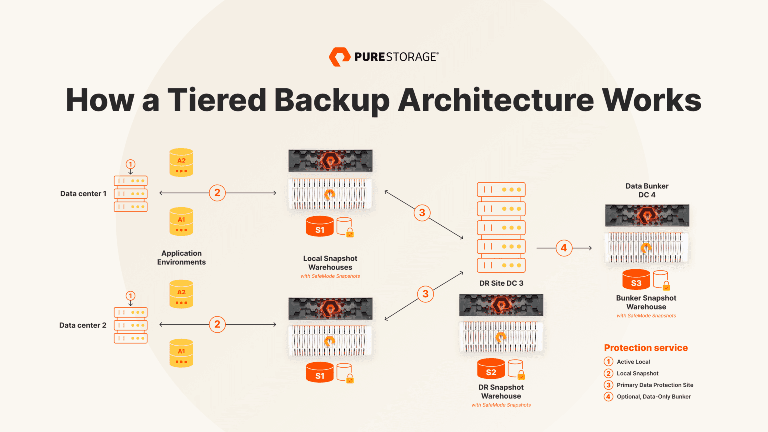ティア 0:ミッションクリティカルなデータ
データ・ストレージの階層化のティア 0 とは、極めて高性能で低遅延のデータ・ストレージ・ソリューションを必要とするミッションクリティカルなデータ用に指定された、最高かつ最速の階層をさします。この階層は、遅延やダウンタイムによって重大な財務損失、評判の低下、運用の中断が発生するアプリケーションや運用に不可欠です。ティア 0 ストレージは、コストがかかるため慎重に使用する必要があります。
ティア 0 データの例:リアルタイムの金融取引、インスタント・アクセスを必要とするオンライン・ゲームデータ、インフラや緊急サービスに使用されるような重要なアプリケーションのためのデータベース・システム
ティア 0 ストレージで使用されるストレージ・メディアの種類:頻繁にアクセスされるデータは、不揮発性メモリ・エクスプレス・ソリッドステート・ドライブ(NVMe SSD)、インメモリ・データベース、カスタム・ハードウェア・アクセラレータなどの高性能ストレージで容易に利用できる必要があります。
ティア 1:ホットデータ
ホット・データとは、アクセス頻度の高いデータをさします。高速アクセスには、スケーラブルで高性能なストレージが必要です。このデータクラスは、SSD などの最速のストレージ・メディアに保存されるため、高速な取得と応答が可能です。
ティア 1 データの例:トランザクション・データベース、頻繁にアクセスされる顧客記録、現在のプロジェクト・ファイル
ティア 1 ストレージで使用されるストレージ・メディアの種類:SSD、インメモリ・データベース、高速ストレージ・アレイ
ティア 2:ウォームデータ
ウォームデータは重要ですが、ホットデータほど頻繁にアクセスされることはありません。SSD と従来の HDD の組み合わせなど、性能とコストのバランスが取れたストレージ・メディアに保存されます。
ティア 2 データの例:月次レポート、過去の売上データ、定期的にアクセスされるアーカイブ
ティア 2 ストレージで使用されるストレージ・メディアの種類:SSD と従来の HDD を組み合わせたハイブリッド・ストレージ・アレイ
ティア 3:コールドデータ
コールドデータは、アクセス頻度の低い情報で構成されており、価値は維持されますが、高速アクセスは不要です。コールドデータは、低コストの HDD やクラウド・ストレージなど、より低速でコスト効率の高いストレージ・ソリューションに保存されます。このデータクラスは、性能よりもコスト効率を重視しています。
ティア 3 データの例:古いプロジェクト・ファイル、アーカイブ文書、履歴記録
ティア 3 ストレージで使用されるストレージ・メディアの種類:HDD、クラウド・ストレージ、テープ・ストレージ
アーカイブ・データ
アーカイブ・データは、コンプライアンスや長期ストレージの目的で保持されるデータで構成されており、データ・バンカーに保存されることもあります。テープ・ストレージやディープ・アーカイブ・クラウド・サービスなど、コスト効果が高くスケーラブルなストレージ・オプションに移行されることがよくあります。これは、組織が法的または運用上、長期間保持する義務がある、アクセス頻度が最も低い情報です。
アーカイブ・データの例:コンプライアンス目的の規制遵守文書および履歴記録
アーカイブ・データに使用されるストレージ・メディアの種類:テープ・ストレージ、光学ストレージ、クラウド・ベースのアーカイブ・ソリューション
階層型ストレージのメリット
階層型ストレージの主なメリット:
1. コスト効率
階層型ストレージは、必要なデータにのみ高性能リソースを割り当てることでコストを最適化します。アクセス頻度の低いデータは、よりコスト効率の高いメディアに保存できます。
2. 性能の最適化
ストレージ・ソリューションを特定のデータ要件にあわせて調整することで、階層型ストレージは、重要なアプリケーション用に高性能リソースを確保し、全体的なシステム効率を向上させます。
3. スケーラビリティ(拡張性)
データの増加に伴い、階層型ストレージ・システムは、階層ごとに適切なストレージ・メディアを追加することで容易に拡張でき、進化するデータ要件に対応する柔軟でスケーラブルなソリューションを提供します。
階層化とキャッシュ
「ティアリング」と「キャッシング」という用語は、時として同じ意味で使用されることがあり、混乱を引き起こすことがあります。しかし、データ・ストレージの概念は異なります。
階層化には、アクセス・パターンに基づいて異なるストレージ層間でデータを物理的に移動させることが含まれます。データは、恒久的に別のストレージ・メディアに移転されます。
キャッシュは、頻繁にアクセスされるデータを保存する一時的なストレージ・エリアを使用しており、より遅いプライマリ・ストレージからデータを取得する必要性を減らすことで性能を向上させます。
まとめ
階層型データ・ストレージは、利用パターンに基づいてデータを効率的に管理するための戦略的アプローチです。データを異なる階層に分類し、適切なストレージ・メディアを利用することで、性能、コスト、スケーラビリティのバランスを取ることができます。
データ・ストレージを次のレベルに引き上げたい方のために、オールフラッシュ・データセンターの時代が到来しました。オールフラッシュ・ストレージ・インフラの導入により、効率的でコスト効率が高く、あらゆる階層で超高速の性能を実現します。
オールフラッシュ・データ・ストレージのメリットと実装について詳しくは、こちらをご覧ください。






